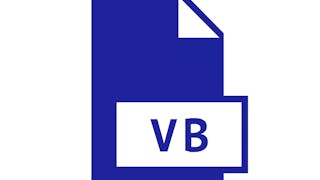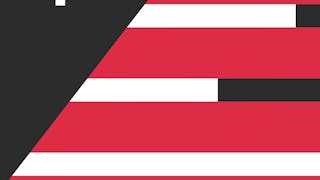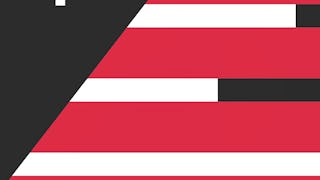Welcome to Introduction to Programming: Visual Basic. In the course sequence you will learn to write programs that utilize both procedural and object oriented techniques to solve business problems. In the first course in the sequence we will provide you with a solid foundation in the computer science topics that are important to understand when programming Visual Basic. In courses two through four, we will role up our sleeves and start coding in Visual Basic. In these courses you need to have access to a computer that is running Windows, macOS or Linux with the .NET 5 installed. We will show you how to install .NET 5.

Enjoy unlimited growth with a year of Coursera Plus for $199 (regularly $399). Save now.

Foundations of Computer Science
This course is part of Introduction to Computer Programming with Visual Basic Specialization

Instructor: Aspen Olmsted
9,332 already enrolled
Included with
(112 reviews)
Recommended experience
What you'll learn
Develop computer programs that utilize classes and objects to solve business and mathematical problems
Develop computer programs that utilize collections of variables to solve business and mathematical problems
Model Object Oriented Programs with UML class diagrams
Skills you'll gain
- Programming Principles
- System Software
- Computer Networking
- Debugging
- Computer Architecture
- Computer Programming
- Network Protocols
- Relational Databases
- Computer Science
- Cloud Computing
- SQL
- Software Development
- Network Security
- Database Management
- Analysis
- Computer Hardware
- Automation
- Databases
- Algorithms
- Visual Basic (Programming Language)
Details to know

Add to your LinkedIn profile
20 assignments
See how employees at top companies are mastering in-demand skills

Build your subject-matter expertise
- Learn new concepts from industry experts
- Gain a foundational understanding of a subject or tool
- Develop job-relevant skills with hands-on projects
- Earn a shareable career certificate

There are 5 modules in this course
Welcome to Foundations of Computer Science, the first course of the Key Technologies of Visual Basic Programming specialization. By enrolling in this course, you are taking the first step to kick start your career in computer programming.
What's included
1 video
In the first week of the course, we will learn about algorithms and talk about problem solving using algorithms. We will also learn about some historical events in computation that lead us to where we are today. By the end of this module, you will know how to identify the different types of data analysis and their use cases. So, let's get started!
What's included
4 videos4 readings5 assignments1 discussion prompt
In the second module of this course, we will learn how computers utilize hardware to store data and execute instructions to carry out our algorithms. We will explore binary number systems, Boolean logic, computer circuits and control circuits. We will look at the primary machine architecture that has been used in all modern machines.
What's included
4 videos4 readings5 assignments1 discussion prompt
In the third module of this course, we will learn how connecting computers offers opportunities and challenges. We will discuss how computer communicate with each other and ways we can protect the computers while sending communication.
What's included
5 videos4 readings5 assignments1 discussion prompt
In the fourth module of this course, we will touch on some important remaining topics required to understand the place of the software we develop. We will dive into the low-level languages used in computing including assembler and machine language. We then will look at databases as most applications need to store data. Lastly, we will look at how automation and artificial intelligence will affect the programs we develop
What's included
4 videos4 readings5 assignments1 discussion prompt
Earn a career certificate
Add this credential to your LinkedIn profile, resume, or CV. Share it on social media and in your performance review.
Instructor

Offered by
Explore more from Software Development
 Status: Free Trial
Status: Free TrialLearnQuest
 Status: Free Trial
Status: Free Trial Status: Free Trial
Status: Free Trial Status: Free Trial
Status: Free TrialMicrosoft
Why people choose Coursera for their career




Learner reviews
112 reviews
- 5 stars
76.78%
- 4 stars
14.28%
- 3 stars
3.57%
- 2 stars
1.78%
- 1 star
3.57%
Showing 3 of 112
Reviewed on Jan 26, 2022
Enjoyable teaching. The quizzes seemed quite tricky considering how limited and short the videos were to learn the material. Thanks!
Reviewed on Oct 2, 2022
Excellent pace & materials. A true value added!
Reviewed on Apr 19, 2021
Excellent course and instructor had explained the concepts very clearly.

Open new doors with Coursera Plus
Unlimited access to 10,000+ world-class courses, hands-on projects, and job-ready certificate programs - all included in your subscription
Advance your career with an online degree
Earn a degree from world-class universities - 100% online
Join over 3,400 global companies that choose Coursera for Business
Upskill your employees to excel in the digital economy
Frequently asked questions
To access the course materials, assignments and to earn a Certificate, you will need to purchase the Certificate experience when you enroll in a course. You can try a Free Trial instead, or apply for Financial Aid. The course may offer 'Full Course, No Certificate' instead. This option lets you see all course materials, submit required assessments, and get a final grade. This also means that you will not be able to purchase a Certificate experience.
When you enroll in the course, you get access to all of the courses in the Specialization, and you earn a certificate when you complete the work. Your electronic Certificate will be added to your Accomplishments page - from there, you can print your Certificate or add it to your LinkedIn profile.
Yes. In select learning programs, you can apply for financial aid or a scholarship if you can’t afford the enrollment fee. If fin aid or scholarship is available for your learning program selection, you’ll find a link to apply on the description page.
More questions
Financial aid available,

